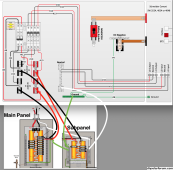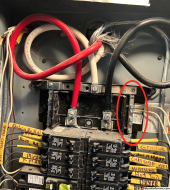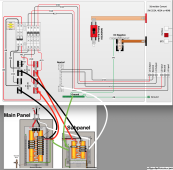MisterSandals
Participation Medalist
I am in the process of installing a Schneider SW4048 with MidNite Solar E-panel in-between my main panel and an existing sub panel (my new critical loads panel).
Its pretty clear that i need to route L1 and L2 from main to SW4048. Return from SW4048 will connect to L1 and L2 in the sub panel.
I am intending to leave neutral to sub panel as is, connected centrally spaced (meaningful?) between L1 and L2. I need to run neutral to the SW4048. My question: Is it important that this neutral connect to the neutral in a centrally spaced location or can it attach anywhere on the side neutral bar in the sub panel (as pictured in the diagram and circled in the pic)?
I would REALLY appreciate any feedback on how i intend to wire the AC side. All the wires will be 8AWG THHN 90C copper. Longest wire will be less than 3ft. All AC amps will all be less than 50A.


Its pretty clear that i need to route L1 and L2 from main to SW4048. Return from SW4048 will connect to L1 and L2 in the sub panel.
I am intending to leave neutral to sub panel as is, connected centrally spaced (meaningful?) between L1 and L2. I need to run neutral to the SW4048. My question: Is it important that this neutral connect to the neutral in a centrally spaced location or can it attach anywhere on the side neutral bar in the sub panel (as pictured in the diagram and circled in the pic)?
I would REALLY appreciate any feedback on how i intend to wire the AC side. All the wires will be 8AWG THHN 90C copper. Longest wire will be less than 3ft. All AC amps will all be less than 50A.





